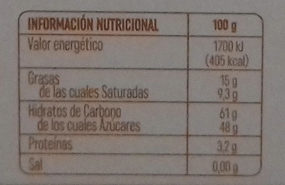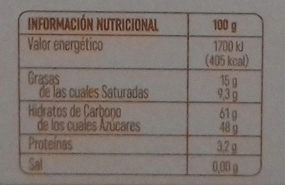Chocolate negro con naranja de Valencia confitada - Lacasa - 150 g
This product page is not complete. You can help to complete it by editing it and adding more data from the photos we have, or by taking more photos using the app for Android or iPhone/iPad. Thank you!
×
Código de barras: 8410740912952 (EAN / EAN-13)
Common name: Naranjas confitadas con chocolate negro
Cantidade: 150 g
Empaquetado: en:Plastic, en:Box, en:container
Marcas: Lacasa
Categorías: en:Snacks, en:Sweet snacks, en:Cocoa and its products, en:Confectioneries, en:Chocolate candies, en:Bonbons, en:Fruit confectioneries, en:Chocolate covered fruits
Etiquetas, certificacións, premios:
en:No gluten, en:Vegetarian, en:Green Dot, en:In braille, en:No palm oil
Link to the product page on the official site of the producer: https://lacasa.es/
Tendas: Carrefour, Alcampo, Eroski, El Corte Inglés, Hipercor
Country: España
Matching with your preferences
Medio ambiente
Empaquetado
Transportation
Report a problem
Data sources
Product added on by neptuno
Last edit of product page on by thaialagata.
Páxina do produto tamén editada por kiliweb, packbot, yuka.U0xzZk9aWUErcVpSa05zWTl3N1crUEF2enJ1Q1FXK1RKUEErSUE9PQ, yuka.YUpoUkNJMGpnUDB4dlBCdXp6UDd4c2hjLzVXdFdXU3hLYlJPSUE9PQ.











